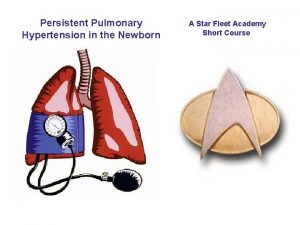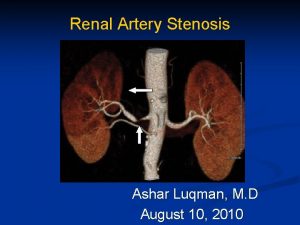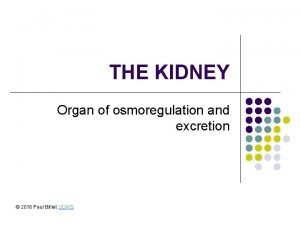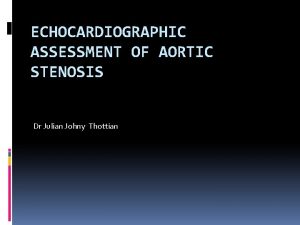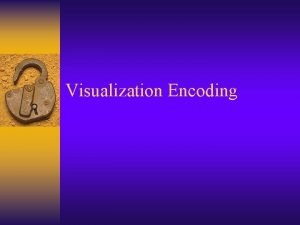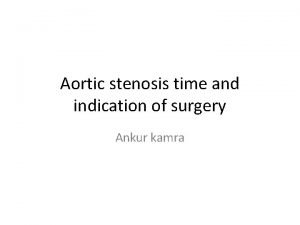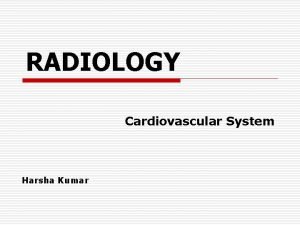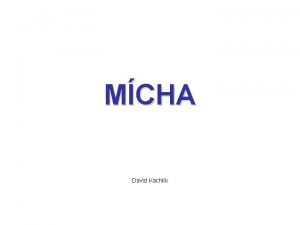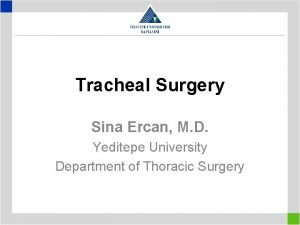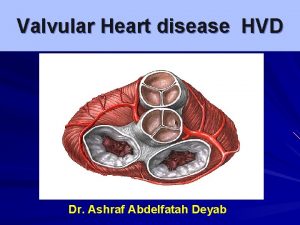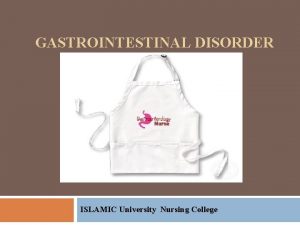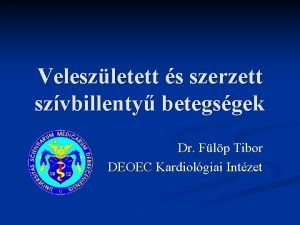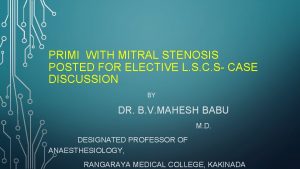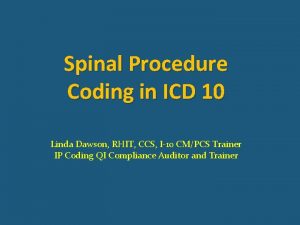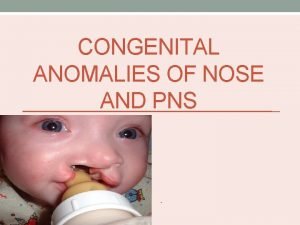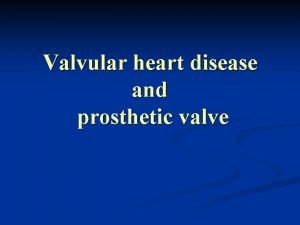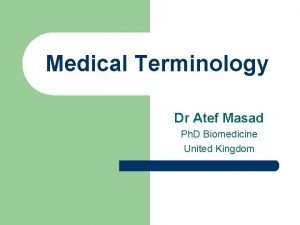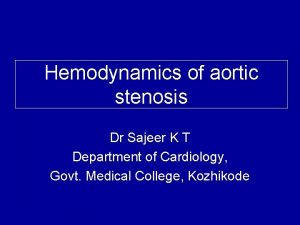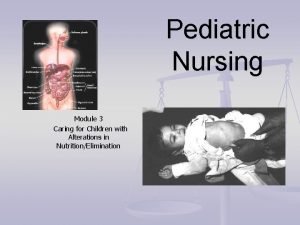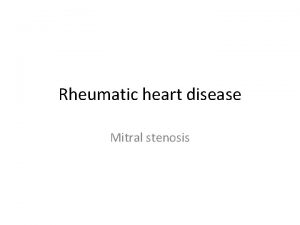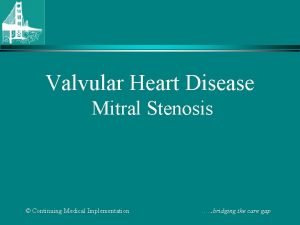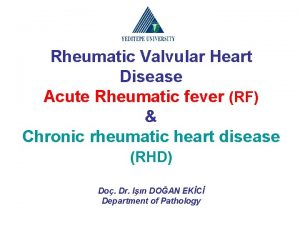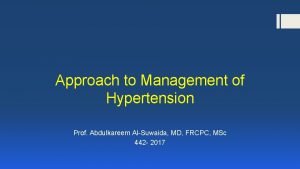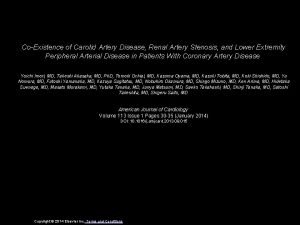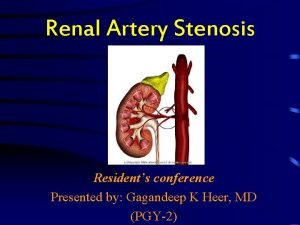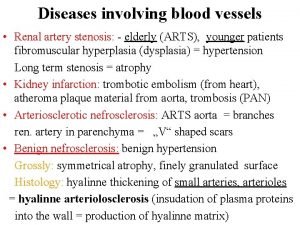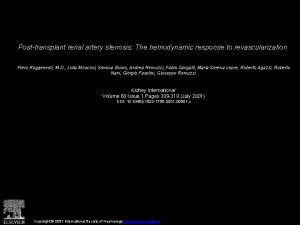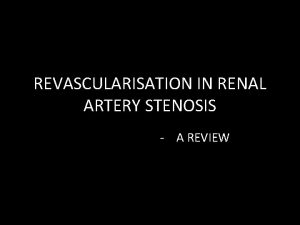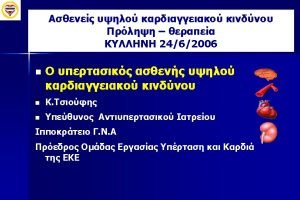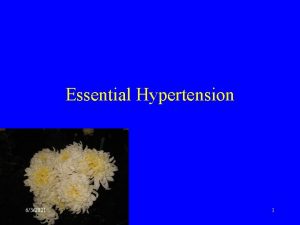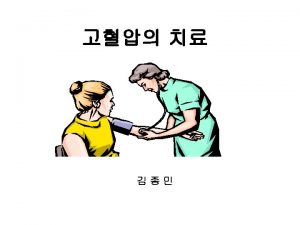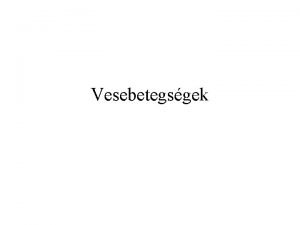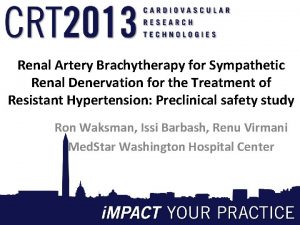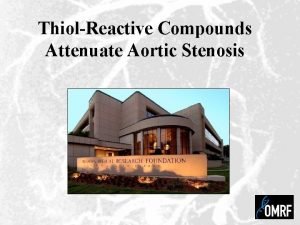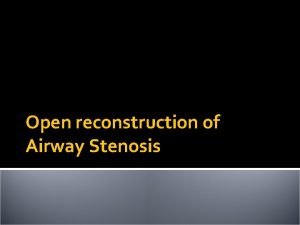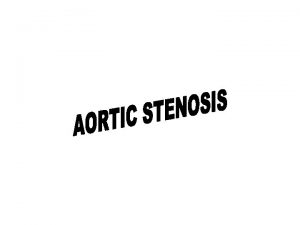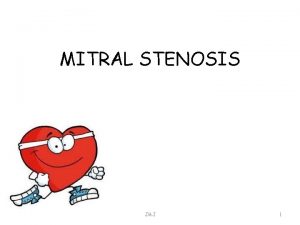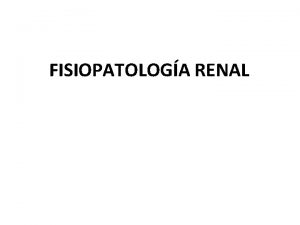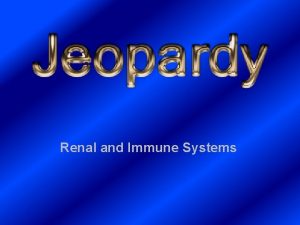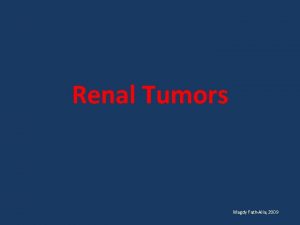Renal Artery Stenosis An important cause of hypertension










































- Slides: 42

Renal Artery Stenosis: An important cause of hypertension Dr Claire Hathorn Sp. R, RHSC Edinburgh 11 th May 2010

Presentation • 3 year old girl • Well • Minor intercurrent illness – A&E • BP 144/91

History & Examination • Asymptomatic • PMH – Eczema, viral induced wheeze • FH – nil of note • Normal examination • Height and weight on 97 th centile

Initial Investigations • BP 120 -140 / 90 -100 mm. Hg • • • Urinalysis negative FBC, U&Es, LFTs, coagulation 4 limb BP ECG Renal USS & dopplers • ALL NORMAL

Further Investigations • • • Renin Aldosterone Cortisol PTH ACTH Complement C 3 C 4 ANA 2. 6 136 192 34 12 560 1. 01 0. 18 neg • Urine catecholamines N • Urine cortisol 11. 9 • Urine prot: creat ratio 39 (slightly raised) • Urine MC&S negative

Radiology • Echo – normal • DMSA – divided function 50% • MR Angiogram – slight irregularity of superior surface of right renal artery, felt unlikely to represent stenosis. No evidence of duplex. Conclusion: normal.

DMSA

MR Angiogram

Specialist Opinions • Cardiology: – No clinical evidence of coarctation – No LVH on Echo • Ophthalmology – Examination normal – No hypertensive retinopathy • No cause or complication of hypertension

Impression & Management • Blood pressure not well-controlled on 3 drugs – Atenolol 20 mg bd – Amlodipine 2. 5 mg od – Doxazosin 0. 5 mg od • Renovascular disease most likely diagnosis • Referred formal angiography at Great Ormond Street Hospital

Angiography • Critical stenosis of left upper pole branch of main renal artery • Normal right renal arteries • Angioplasty performed • Atenolol & Doxazosin stopped • Aspirin started

Progress • Remained hypertensive 1 month postangioplasty: 120/61 • Amlodipine continued • Doxazosin restarted • 3 months post-angioplasty, BP well-controlled: 50 -75 th centile

Discussion

Renovascular Hypertension • • Aetiology Clinical Features Investigations Management

Renovascular Hypertension • 5 -10% of all childhood hypertension • Amenable to potentially curative treatment • Causes & management different to adults

Aetiology in Children • Fibromuscular dysplasia – most common in UK • • Syndromes: Neurofibromatosis, Williams, Marfan Vasculitides: Takayasu, Kawasaki Extrinsic compression: Wilm’s, Neuroblastoma Other: Renal transplant, trauma, radiation

Clinical Spectrum • Bilateral disease in 53 -78% • Intrarenal disease in 44% • Intrarenal & main artery stenosis in 31% • Most children without co-morbidities have single focal branch artery stenosis Tullus et al. Renovascular hypertension in children. Lancet. 2008; 371: 1453 -1463

Anatomic distribution of renal artery stenosis in children: implications for imaging • • • Cinncinnati Children’s Hospital, 1993 -2005 24 stenoses identified in 21 children, R=L 12 male, mean age 9 yrs 3 mths (30 mths – 18 yrs) No co-morbidities 90% children had a single stenosis 75% lesions located in branch / accessory arteries Vo et al. Pediatric Radiology 2006; 36: 1032

Clinical Features Presenting Feature No. n=33 Incidental finding 9 Cardiac (CCF, palpitations, murmur) 7 Headache +/- vomiting & lethargy 6 Acute hypertensive encephalopathy 3 Cerebrovascular accident 2 Facial palsy 2 Failure to thrive 2 Screening for NF 1 2 Schroff et al. Angioplasty for renovascular hypertension in children: 20 year experience. Pediatrics 2006; 118: 268 -275

Renovascular disease and more widespread arterial involvement Schroff et al 2006 (%) 48 Stadermann et al 2010 (%) 51 Intrarenal disease 45 - Cerebral 21 26 Aortic 24 40 - 23 Bilateral RAS Visceral

Implications of widespread arterial disease • Improved BP control – 11/13 (85%) isolated RAS – 6/20 (30%) associated intra or extra renal disease • Recommend routine cerebrovascular imaging – MR / PET scanning Schroff et al. Angioplasty for renovascular hypertension in children: 20 year experience. Pediatrics 2006; 118: 268 -275

Investigation • Doppler ultrasound • Measurement of plasma renin activity – Captopril plasma renin test – Renal vein sampling • Scintigraphy: DMSA or MAG 3 • CT & MR angiography • Angiography: Gold Standard

DMSA scintigraphy before & after Captopril Tullus et al. Renovascular hypertension in children. Lancet. 2008; 371: 1453 -1463

CT Angiogram Tullus et al. Renovascular hypertension in children. Lancet. 2008; 371: 14531463

MR Angiogram

Angiography • With carefully selected patients, 40% RAS • Important therapeutic opportunity • Visualisation of abdominal vessels

Angiography: Indications • Tulles et al. (2008) – BP >95 th centile not well-controlled on 2 drugs – Other cause not identified • Vo et al. (2006) – Unexplained persistent HT > 95 th centile • Shahdadpuri et al. (2000) – BP > 99 th centile not controlled with 1 drug – Angiography abnormal in 43% patients

A 4 -year-old hypertensive boy Vo et al. Anatomic distribution of RAS in children. Pediatric Radiology 2006; 36: 1032

14 yr old hypertensive girl Vo et al. Anatomic distribution of RAS in children. Pediatric Radiology 2006; 36: 1032

Medical Management • Anti-hypertensives – Multiple often required – Adequate BP control often not possible – Adverse effects common – Avoid ACE inhibitors & angiotensin receptor blockers • Concern re renal function if BP well-controlled due to under-perfusion of kidneys

Angioplasty • 1980 : 1 st successful angioplasty in a child • Balloon diameter equal to proximal artery • Stent if residual diameter stenosis <50% • Complications – Arterial spasm – Dissection – Arterial rupture • Post-procedure: Aspirin 3 -6 months Tullus et al. Renovascular hypertension in children. Lancet. 2008; 371: 1453 -1463

Angioplasty for renovascular hypertension in children: 20 year experience • Retrospective review from GOS • All children undergoing PTA 1984 -2003 – Only stenoses in main or large segmental arteries – Excluded transplants & inflammatory disorders • 33 children, 1. 9 -17. 9 yrs (median 10. 3) – 10 with underlying syndromes – 16 bilateral RAS – 15 intrarenal disease • 48 procedures, including 15 stents Schroff et al. Pediatrics 2006; 118: 268 -275

Angioplasty for renovascular hypertension in children: 20 year experience • Final outcomes of PTA: – 18 (55%) improved BP control • 11/13 (85%) if isolated main RAS – 10 (30%) ongoing HT despite adequate dilation – 5 (15%) PTA unsuccessful – Restenosis in 2/27 native renal arteries after balloon dilatation, 7/19 of stented arteries – 6 (18%) suffered complications, incl 1 death Schroff et al. Pediatrics 2006; 118: 268 -275

Left RAS before & after Angioplasty Schroff et al. Angioplasty for renovascular hypertension in children: 20 year experience. Pediatrics 2006; 118: 268 -275

Surgery • For refractory HT when medical Rx & angioplasty have failed • Nephrectomy • Revascularisation procedures • Aortic reconstruction

Results of surgical treatment for RVH in children: 30 yr single centre experience • • 37 children (65% male) 1979 - 2008 Mean SBP 140 (105 -300) mm. Hg 53 surgical procedures – Nephrectomy – Renovascular surgery – Aortic reconstruction 18 28 7 Stadermann et al. Nephrology Dialysis Transplantation. 2010; 25(3): 807 -813

Results of surgical treatment for RVH in children: 30 yr single centre experience • 12 months post-op: – 16 (43%) normal BP without treatment – 15 (41%) normal/improved BP on 1 -4 drugs – 4 (11%) unchanged • 90% overall improvement • Complications: – Haemorrhage (5) – Septicaemia (5) – Chylous ascites (1) Stadermann et al. Nephrology Dialysis Transplantation. 2010; 25(3): 807 -813

Children not amenable to Angioplasty or Surgery • Diffuse abnormalities of very small intrarenal arteries • Antihypertensive medication – Uncontrolled on 6 -7 drugs not uncommon • Therapeutic trial with ACE inhibitor or angiotensin blocker warranted Tullus et al. Renovascular hypertension in children. Lancet. 2008; 371: 1453 -1463

Suggested Investigations(Tullus 2008) BP >90 th centile, confirm with ABPM Confirmed HT >95 th centile BP 90 -95 th centile Primary Ix incl doppler US Monitor No cause identified BP well-controlled on 1 -2 drugs No further Ix BP poorly controlled on 2 drugs Scintigraphy &/or CT/MR Angiography Findings suggestive/clinical suspicion of RVH Angiography & renal vein sampling

Drug treatment without ACE-I or angiotensin receptor blocker BP not well-controlled or needing >2 drugs Angioplasty Surgery BP >95 th centile - Reconstructive surgery BP still >95 th centile – further drug treatment incl cautious use of ACE -I Tullus et al. Renovascular hypertension in children. Lancet. 2008; 371: 1453 -1463

Our Patient • 3 months post-angioplasty • BP well-controlled on 2 drugs • Close follow-up – BP – Renal function – DMSA • ? Consider cerebrovascular imaging

Any Questions?
 Ira pré renal renal e pós renal
Ira pré renal renal e pós renal Ira pré renal renal e pós renal
Ira pré renal renal e pós renal Mitral stenosis pulmonary hypertension
Mitral stenosis pulmonary hypertension Artery stenosis
Artery stenosis Distinguish between renal corpuscle and renal tubule
Distinguish between renal corpuscle and renal tubule Renal artery branches
Renal artery branches Branches of sma
Branches of sma Hypertrophic pyloric stenosis
Hypertrophic pyloric stenosis Aortic stenosis echo criteria
Aortic stenosis echo criteria Subglottic stenosis
Subglottic stenosis Pathophysiology of valvular heart disease
Pathophysiology of valvular heart disease Pylomyotomy
Pylomyotomy Stages of aortic stenosis
Stages of aortic stenosis Atheromatous thoracic aorta
Atheromatous thoracic aorta Stenosis canalis spinalis
Stenosis canalis spinalis Tetralogy of fallot xray
Tetralogy of fallot xray Cricoid cartillage
Cricoid cartillage Tendinous cords
Tendinous cords Pyloric stenosis nursing diagnosis
Pyloric stenosis nursing diagnosis Lovagló aorta
Lovagló aorta Wilkins score ms
Wilkins score ms Vertebroplasty icd 10 code
Vertebroplasty icd 10 code Most common congenital anomalies
Most common congenital anomalies Pyloric stenosis
Pyloric stenosis Rvh cxr
Rvh cxr In the word pelvimetry, the combining vowel is
In the word pelvimetry, the combining vowel is Lumbar radic icd 10
Lumbar radic icd 10 Pressure gradient in heart
Pressure gradient in heart Pedalute
Pedalute Palpable p2
Palpable p2 S2 os gap
S2 os gap Cervical stenosis cervix
Cervical stenosis cervix Fish mouth buttonhole stenosis
Fish mouth buttonhole stenosis Proximate cause and ultimate cause
Proximate cause and ultimate cause Proximate and ultimate causes of behaviour
Proximate and ultimate causes of behaviour Difference between innate and learned behavior
Difference between innate and learned behavior Ter thin client
Ter thin client From most important to least important in writing
From most important to least important in writing From most important to least important in writing
From most important to least important in writing Least important to most important
Least important to most important Hypertension investigation chart
Hypertension investigation chart Hypertension urgency vs emergency
Hypertension urgency vs emergency Antihypertensive drugs
Antihypertensive drugs


